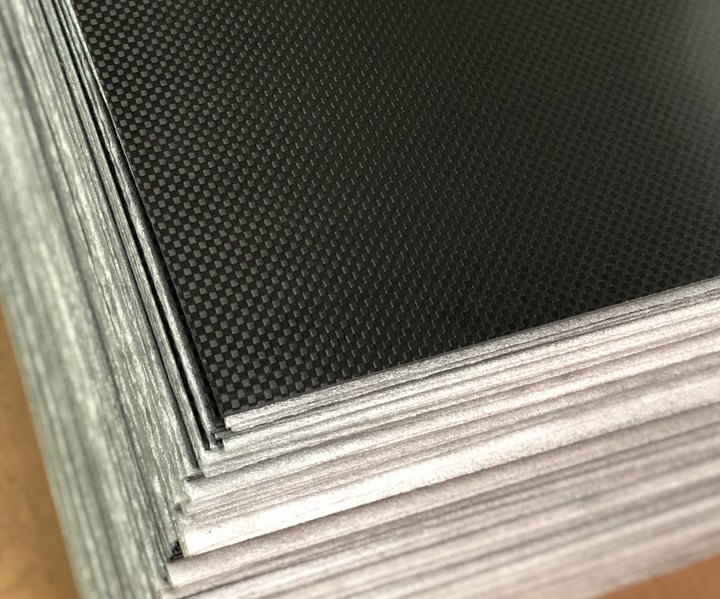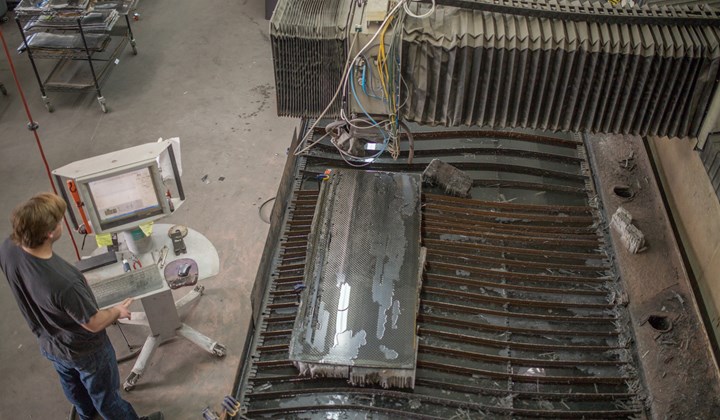From carbon fiber skateboard maker to contract manufacturer
Elevated Materials makes its mission to deliver reclaimed high-quality aerospace carbon fiber to a variety of industries.
(Gardena, Calif., U.S.) takes a bit of an unconventional approach to recycling carbon fiber. While studying aerospace engineering at the University of Southern California (USC, Los Angeles, Calif., U.S.), company founder and CEO Ryan Olliges saw the amount of unused carbon fiber being sent to the landfill. With the help of USC assistant professor Greg Autry, he launched 121C Inc. (learn more about 121C Inc. in “Compression molding: New Materials and Markets”) and and built a heated press to create carbon fiber skateboards. Once the fledgling company realized just how much carbon fiber scrap existed, it saw a larger opportunity to do more than just make skateboards. Olliges says the ultimate goal wasn’t just to be a skateboard company, but to save the valuable material from the landfill and use it to do something good for the earth.

Elevated Materials got its start pressing carbon fiber skateboards and has grown into a contract manufacturing company.
Source | Elevated Materials
“Between 20 and 40% of material is thrown away from the production line,” says Olliges, speaking of the commercial aerospace and space flight industries. “And that’s still good, unused material.”
The company soon began receiving inquiries about parts that other companies wanted made for them and recognized this as an opportunity to make use of even more waste material. At that point it transformed into a contract manufacturing company to service numerous industries with reclaimed material, and the Elevated Materials brand was born.
Elevated Materials’ mission is to deliver high-quality, aerospace-grade carbon fiber to industries that haven’t considered using the material due to cost. The company collects carbon fiber trim scrap, ply cutter trim scrap, excess tape rolls and expired material and sorts it and cuts into standardized shapes. Those shapes are then sorted into kits, laid up in a mold and pressed into cured flat sheets. Olliges says outlife of the material isn’t a huge problem as the trim scrap is collected on a daily basis and most of the material goes directly to the hot press to be processed. The company freezes any material that isn’t used immediately and employs a tracking and identification system to insure left-over material is used within its shelf life..

Elevated Materials creates parts from stock sheets it presses from reclaimed carbon fiber, and can make custom-sized sheets to order based on the application and the material on hand.
Source | Elevated Materials
Elevated Materials stocks different thicknesses of sheets and has machining capabilities to cut those pieces into different products. Parts can be created from stock sheets, or custom-sized sheets can be made to order based on the application and the material on hand. Sheets range from quasi-isotropic layups to aluminum honeycomb panels and can be made to a custom thickness and then cut into any size or shape that is needed. CNC routers and waterjet cutters are used to cut parts, and the company continues to explore ways to expand its offerings.
“As we design and build out our manufacturing capabilities, we make use of open-source software, self-fabricated equipment and IoT data collection to implement a system for process control and rapidly scale for our customers,” says Elevated Materials’ CTO Jaysen Harris.

Elevated Materials CEO Ryan Olliges oversees a waterjet cutting operation. The company uses both CNC routers and waterjet cutters to cut parts for drones and other machined components.
Source | Elevated Materials
“So many industries out there want to use carbon fiber, but it’s so cost prohibitive,” says Olliges. “We can deliver really good high-quality aerospace material to industries that haven’t considered using it before.”
Elevated Materials has worked with a range of clients in the consumer product space. Product examples include snare drum shells, drones and brackets for T-slot framing as well as aftermarket for automotive, ATVs and motorcycles. Olliges’ current favorite products are road cases for concert or film equipment. He says the cases have the potential to consume tens of thousands to hundreds of thousands of pounds of recycled material.
Olliges thinks there’s eventually potential for the company to make bulk molding and sheet molding compounds (SMC) for use in panels for the automotive market.
Related Content
Matrix Composite highlights carbon fiber SMC prepreg Quantum-ESC
Prepreg produced by LyondellBasell features high flow, rapid tool loading capabilities.
Read MoreComprehensive service formulates standard, custom SMCs
CAMX 2024: As an SMC product manufacturer, Molding Products LLC provides SMC formulations and technical support for diverse markets, from R&D to post-production.
Read MoreIDI Composites opens new global headquarters, manufacturing and technology center
The Noblesville, Indiana, facility includes SMC and BMC manufacturing, an R&D center and the company’s corporate headquarters.
Read MoreSMC composites progress BinC solar electric vehicles
In an interview with one of Aptera’s co-founders, CW sheds light on the inspiration behind the crowd-funded solar electric vehicle, its body in carbon (BinC) and how composite materials are playing a role in its design.
Read MoreRead Next
Next-gen fan blades: Hybrid twin RTM, printed sensors, laser shock disassembly
MORPHO project demonstrates blade with 20% faster RTM cure cycle, uses AI-based monitoring for improved maintenance/life cycle management and proves laser shock disassembly for recycling.
Read MoreScaling up, optimizing the flax fiber composite camper
Greenlander’s Sherpa RV cab, which is largely constructed from flax fiber/bio-epoxy sandwich panels, nears commercial production readiness and next-generation scale-up.
Read MoreCutting 100 pounds, certification time for the X-59 nose cone
Swift Engineering used HyperX software to remove 100 pounds from 38-foot graphite/epoxy cored nose cone for X-59 supersonic aircraft.
Read More












